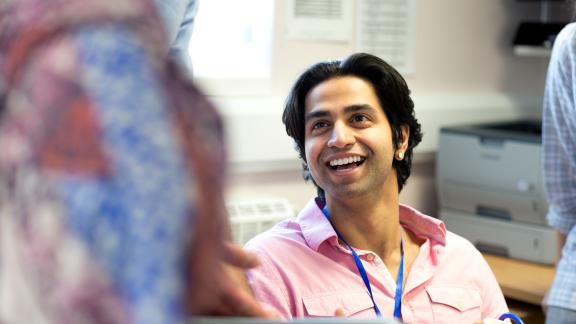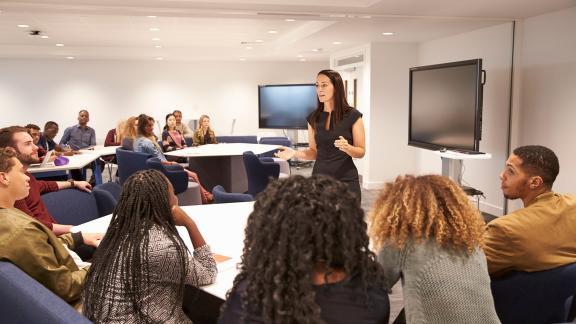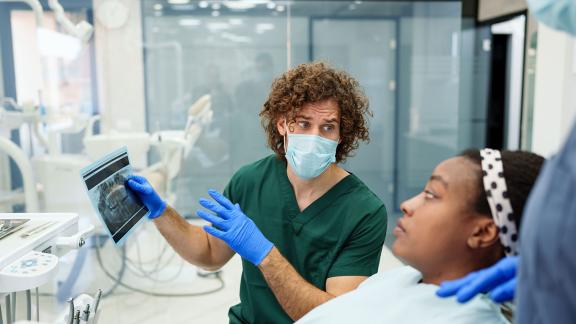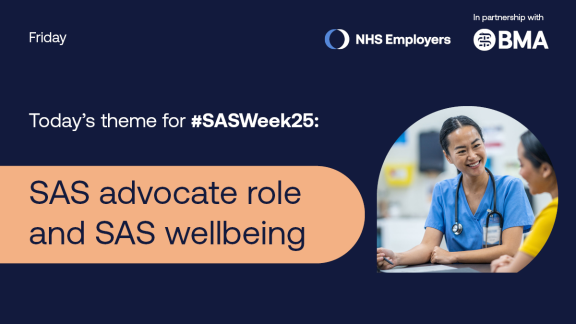How LED induction can support international medical graduates

Introduction
Chelsea and Westminster Hospital NHS Foundation Trust identified that locally employed doctors (LEDs), particularly international medical graduates (IMGs), were entering NHS roles without consistent or appropriate induction. So the trust launched a collaborative, multi-trust induction programme to improve onboarding, integration, and retention. The initiative has supported nearly 400 IMGs who have come through the induction programme, coming from multiple different countries and a wide range of specialties.
Key benefits and outcomes
- The programme reduces isolation by connecting IMGs in similar situations, helping early friendships and professional networks form.
- IMGs who attend induction tend to settle more quickly and transition out of supernumerary roles sooner than those who do not.
- IMGs report feeling more equipped to start their roles and navigate the NHS systems more effectively.
- The programme has helped reduce onboarding strain, has improve workforce stability and enhanced patient safety.
“I’m glad that trusts are taking into consideration the lack of knowledge about the NHS of IMGs and help us in our integration into the system before we start working”.
What the organisation faced?
Chelsea and Westminster Hospital NHS Foundation Trust recognised a gap in the onboarding experience for LEDs. Many IMGs were entering clinical roles without structured induction, leading to confusion, delayed integration, and inconsistent support across departments. This lack of preparation affected confidence, performance and retention.
The issue was not isolated to one trust. After speaking with neighbouring trusts, it was discovered that they were facing similar challenges. Chelsea and Westminster Hospitals saw this as an opportunity to create a collaborative solution that could benefit the trusts in its region.
What the organisation did?
Chelsea and Westminster Hospital established an IMG office in August 2023, which was initially supported by funding from Health Education England (HEE). A small team was formed, including two education fellows, a programme manager, administrative support and a medical lead. The team contacted each neighbouring trust, which included HR and medical education teams, to form a collaborative group consisting of members from all four trusts involved. They then designed a five-day induction programme to support IMGs within their first year of NHS employment.
The programme runs monthly with all newly appointed IMGs invited to attend. Referrals are coordinated through HR, medical education leads, and specialty departments, particularly in acute areas such as A&E, surgery, and anaesthetic specialities. Monthly meetings allowed for shared learning, troubleshooting, and continuous improvement made to the induction week.
Peer support is a key part of the programme’s success. IMGs further along in their journey offer personal insights, practical tips, and a safe space for new colleagues to ask questions they may not feel comfortable raising in clinical settings. These can include everyday challenges like opening a bank account, finding accommodation, or locating shops that sell familiar food from their cultural background.
Participants receive hands-on training with electronic patient records and clinical documentation, boosting confidence and readiness for practice.
IMGs are guided on how to navigate training pathways, build their professional portfolio, and plan their career progression within the NHS something which previously had been highlighted as a source of confusion.
Key features of the programme include:
- career development guidance, including training pathways and portfolio building
- peer networking and cultural orientation
- interactive sessions to enhance engagement
- audit and quality improvement
- documentation and discharge summaries.
Results and benefits
The programme has inducted nearly 400 IMGs from a wide range of specialties and countries. Most participants remain in post for at least one year and those who move tend to stay within the NHS, with some progressing into training posts or specialty doctor roles. Some moved outside of London due to wanting to live elsewhere or for family commitments.
Feedback from doctors has been positive. Participants report feeling more confident, better prepared, and more connected to their peers. Supervisors note that IMGs who attend induction settle faster, require less time in shadowing roles, and contribute more effectively to clinical teams.
The programme has also led to:
- development of weekly education sessions across trusts
- expansion of clinical attachment opportunities
- creation of centralised resources for career development and support.
It costs the trust approximately £400,000 per year to run the programme but the trusts’ view it as a vital investment for IMGs. The programme has helped reduce onboarding strain, helped improve workforce stability and enhanced patient safety.
“The inclusion of distinguished speakers from diverse backgrounds, particularly those with significant experience and senior positions greatly enriched the learning experience”.
Overcoming obstacles
One of the biggest challenges the trust faced was securing time for IMGs to attend the five-day induction. Departments have been concerned about service pressures and staffing gaps so allowing their IMGs to be away for five days could cause additional staffing issues. The team held discussions with consultants, and the service leads initially to explore the potential benefits. After that there were negotiations with medical directors at each trust with board-level approval secured from the medical directors.
Supervisors have fed back that the IMGs going through the programme tend to settle in much faster and move away from supervised induction periods much faster. Despite losing an IMG for five days, the end result is a doctor who can work more effectively and ensures better patient outcomes.
The induction programme runs monthly to ensure IMGs can attend within their first month of employment. It is understood that this might not always be possible, but efforts are made to ensure all IMGs are able to attend. While early attendance is preferred, the programme accepts referrals up to 12 months post start, especially for doctors who may need additional support.
Another challenge was the request for specialty specific content. With IMGs spanning multiple trusts and specialties, it was not feasible to tailor sessions to each speciality. Instead, the programme focuses on generic NHS practice and encourages departments to provide robust local induction specific to that area of work.
Takeaway tips
- Have monthly meetings between all trusts involved in the programme. This allows shared learning, open dialogue and trusts able to share good practice
- Prioritisation peer support and cultural orientation is essential to make IMGs feel welcome in the trust.
- Offer flexible induction windows to accommodate service pressures.
- The feedback from IMGs is used to improve content and delivery.
“The best gathering I have had since I arrived in the UK. I am more prepared and confident to face the challenges out there”.
Further information
For more information about the work in this case study, contact Kwaku Baryeh, NWL IMG Education Fellow at Chelsea and Westminster Hospital NHS Foundation Trust: kwaku.baryeh@nhs.net or chelwest.imgoffice.nwl@nhs.net.
We would love to hear other examples of approaches to employing LEDs.
If you would like to share the work your organisation is doing please contact us.



